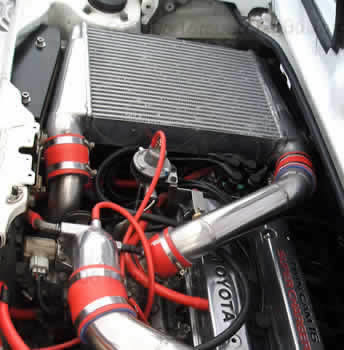Forced air induction turbos vs superchargers
"Foie Gras with Air for engines!"
Both work on the same principle they blow air into the engine under pressure. Both have a turbine which spins up depending on the engine speed and the higher the revs the greater the volume of air is forced into the engine.
There the similarity ends. The superchargers take the engine crank rotation and through a gearing system drive the turbine. Superchargers have a smooth power delivery right across the rev range even from low down.
Turbo chargers are a little different – they have two propellers one is driven by the exhaust gases, which is geared up to the intake propeller that sucks in the air. Due to the close proximity of exhaust gases there is a temperature problem. One of the best ways around this is with an intercooler – it works like a radiator and takes the heat out of the air intake charge. The intercooler can be sprayed with water or even nitrous to further cool down the air charge.

Turbos spin faster and produce larger power gains but do not work at lower engine revs. This effect is known as turbo lag but makes a car fun to drive due to the power coming in at around 1500 – 2000 revs often in an explosive manner. Reducing the compression ratio of the engine helps to minimise the turbo lag and risk of detonation – other manufacturers use a smaller turbo or twin turbo to compensate for this problem.
Other ways to avoid detonation (where the extreme pressure and heat in the combustion chamber cause premature ignition damaging the engine) include higher octane fuel and a water injection system to damp things down.
Turbo technology has come on leaps and bounds recently with low friction and high pressure ceramic bearings – variable turbine geometry – twin turbo systems and turbo timing systems to control the amount of boost and vary it depending on throttle position and engine load. Other turbo systems keep the turbo spinning off throttle by igniting fuel in the exhaust to keep the gasses flowing - a trick learnt from motorsport turbo applications.
A forced air induction system can be added to any car although the engine management computer will need remapping.
Please ignore the DIY kits available they are often set up with such low boost that they are not worth having or they will cause major problems if they are not set up correctly with the other components required to make things work smoothly.
The cost of the turbo is only the start you will need to buy lots of other components to get it running - this is one of the best modifications you can get but also is one of the most expensive.
When you get a turbo or larger replacement turbo buy it from a specialist with knowledge of your car and choose one that offers a fitting service and GET A WARRANTEE.
The fuel pump may also need to be uprated because the air in the cylinders is pressurised so the fuel pressure must be greater otherwise no fuel will squirt into the engine and this will somewhat ruin the performance you were hoping for with the engine running lean. The engine gaskets and pipes must also be strong enough to cope with the extra power and pressure.
When you switch off the engine you must allow time for the turbo’s turbine to slow down and cool down. With the engine off the oil flow will stop and a turbo spinning at 100,000 RPM will quickly use up the oil and overheat. A turbo timer will keep the engine ticking over until the turbo is safely wound down but expect helpful people to say “you’ve left your engine running” when you park it. Please see the articles on Boost Controllers and Screamer pipes and Blow Off Valves for more information.
If you liked this page please share it with your friends, drop a link to it in your favourite forum or use the bookmarking options to save it to your social media profile.
Check out TorqueCars new YouTube channel, and see their awesome new content...
Feedback
Please use our forums if you wish to ask a tuning question, and please note we do not sell parts or services, we are just an online magazine.
Help us improve, leave a suggestion or tip
